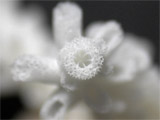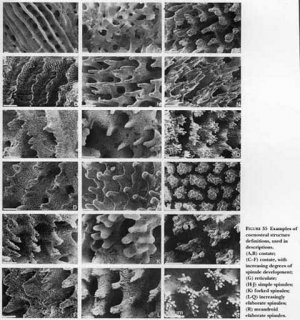Acropora florida group - A. florida, A. sarmentosa
growth form - modified robust hispidose, with even small branches around heavy main branch
radials - evenly sized, appressed tubular, thick labelate lower wall and round openings, radials contribute equally with axials to branch thickness.
cornosteum - reticulate without much spinule development at all between radials, costate or reticulo-costate on radials.
habitat - varies
range - Indo-Pacific, but not Central Pacific
Acropora hyacinthus group - A. hyacinthus, A. tanegashimensis, A. anthocercis, A. cytherea, A. microclados, A. paniculata, A. indonesia
growth form - tables or plates, central or side attachment, thickened stalk; juveniles are digitate before the mature table or plate forms (elaborate horizontal branching/anastomoses with short thin vertical projections)
radials - even sized, labellate, uppper wall absent, lower wall lip is rectangular
coenosteum - reticulate with simple spinules between radials, costate on radials
habitat - most reef zones but often shallow
range - depends on species
Acropora latistella group - A. latistella, A. subulata, A. nana, A. aculeus.
growth form - corymbose, slender branches, varies with depth, can form plates or tables
radials - evenly sized, appressed tubular, round openings, contribute equally with axials to branch diameter, spacing varies with depth
coenosteum - uniform reticulate with well-spaced simple spinules between radials, reticulate to reticulo-costate on radials.
habitat - broad depth range
Acropora horrida group - A. horrida, A. vaughani, A. tortuosa, A. abrolhosensis, A. microphthalma, A. kirstyae, A. derawanensis, A. halmaherae
growth form - highly variable, even within a colony, indeterminate
radials - evenly sized, simple tubular, round openings
coneosteum - simple to elaborate spinules, coenosteum sometimes partly fused, reticulate to costate between and on radials
habitat - variable, usually protected and lower water flow
range - variable
Acropora plumosa group - A. plumosa
growth form - irregular, flat-topped arborescent tables to twisted arborescent, branches 3-15mm diameter up to 50mm long; horizontal branchlets 3-4 mm diameter, sometimes anastomosing, the loose, open tables can form multiple tiers, cream to yellow-brown, yellow-grey, brown color
axials - 1.2-2.1mm OD, 0.6-1.2 ID, primary septa to 2/3 radius, secondary cycle absent or barely developed
radials - even, not touching; tubular; round, oval or dimidiate openings, primary septa to 1/4 radius; secondary cycle absent or barely developed
coenosteum - reticulate to reticulo-costate on radials with laterally flattened spinules, reticulate between radials with laterally flattened spinules between, sometimes in rows
habitat - deep slopes and walls below 40 feet
range - Indonesia and Papua only
4 groups to go...
growth form - modified robust hispidose, with even small branches around heavy main branch
radials - evenly sized, appressed tubular, thick labelate lower wall and round openings, radials contribute equally with axials to branch thickness.
cornosteum - reticulate without much spinule development at all between radials, costate or reticulo-costate on radials.
habitat - varies
range - Indo-Pacific, but not Central Pacific
Acropora hyacinthus group - A. hyacinthus, A. tanegashimensis, A. anthocercis, A. cytherea, A. microclados, A. paniculata, A. indonesia
growth form - tables or plates, central or side attachment, thickened stalk; juveniles are digitate before the mature table or plate forms (elaborate horizontal branching/anastomoses with short thin vertical projections)
radials - even sized, labellate, uppper wall absent, lower wall lip is rectangular
coenosteum - reticulate with simple spinules between radials, costate on radials
habitat - most reef zones but often shallow
range - depends on species
Acropora latistella group - A. latistella, A. subulata, A. nana, A. aculeus.
growth form - corymbose, slender branches, varies with depth, can form plates or tables
radials - evenly sized, appressed tubular, round openings, contribute equally with axials to branch diameter, spacing varies with depth
coenosteum - uniform reticulate with well-spaced simple spinules between radials, reticulate to reticulo-costate on radials.
habitat - broad depth range
Acropora horrida group - A. horrida, A. vaughani, A. tortuosa, A. abrolhosensis, A. microphthalma, A. kirstyae, A. derawanensis, A. halmaherae
growth form - highly variable, even within a colony, indeterminate
radials - evenly sized, simple tubular, round openings
coneosteum - simple to elaborate spinules, coenosteum sometimes partly fused, reticulate to costate between and on radials
habitat - variable, usually protected and lower water flow
range - variable
Acropora plumosa group - A. plumosa
growth form - irregular, flat-topped arborescent tables to twisted arborescent, branches 3-15mm diameter up to 50mm long; horizontal branchlets 3-4 mm diameter, sometimes anastomosing, the loose, open tables can form multiple tiers, cream to yellow-brown, yellow-grey, brown color
axials - 1.2-2.1mm OD, 0.6-1.2 ID, primary septa to 2/3 radius, secondary cycle absent or barely developed
radials - even, not touching; tubular; round, oval or dimidiate openings, primary septa to 1/4 radius; secondary cycle absent or barely developed
coenosteum - reticulate to reticulo-costate on radials with laterally flattened spinules, reticulate between radials with laterally flattened spinules between, sometimes in rows
habitat - deep slopes and walls below 40 feet
range - Indonesia and Papua only
4 groups to go...












